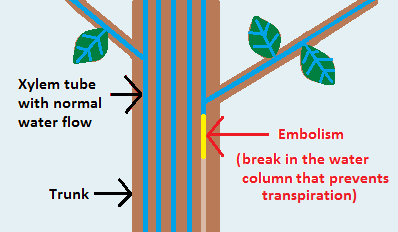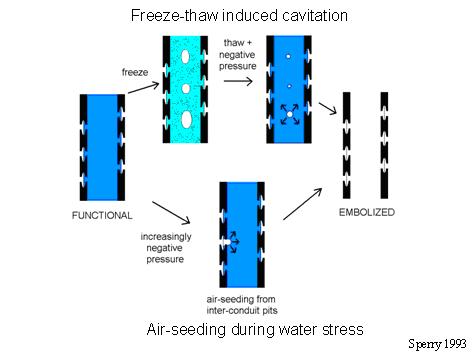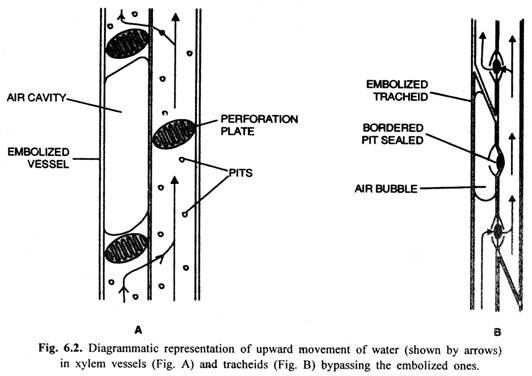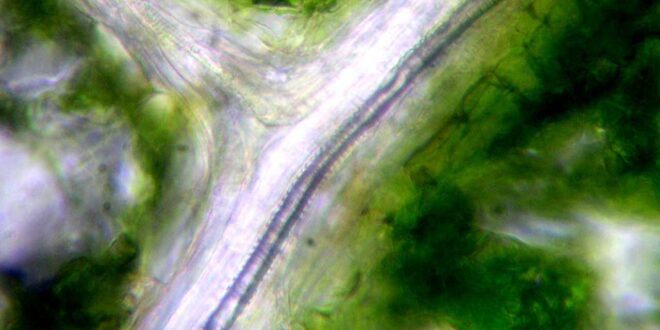Water transportation seems comparatively a simple phenomenon than how plants communicate with each other or the studies regarding whether they feel any pain. Because the transportation system seems so obvious and uninteresting there has been little research on this topic and there lie many other things that are still unknown. The processes believed to be happening in water transportation are imbibition, osmosis, capillary action, and the cohesion of water molecules & transpiration. While imbibition and osmosis work only in the case of soil to root hair water absorption or cell to cell water transportation, capillary action works only in the vascular bundle. But transpiration plays its role in both cellular parts and pipe-like vascular bundles. ‘Cavitation’ and ‘Embolism’ occur right in these tiny and narrow channeled pipes.
The Problem with The Existing Theories
Before even discussing cavitation and embolism I wanna draw your attention first to the problem that we are facing with the existing theories about water transportation processes. According to the theories, transpiration creates a suction pump and this suction force works as long as the columns of water are continuous. Bonding forces cause the water molecules to adhere to each other, and because they are strung together like links in a chain, as soon as space becomes available in the leaf, thanks to transpiration, the bonded molecules pull each other a little higher up the trunk. So simple as that.
Best safe and secure cloud storage with password protection
Get Envato Elements, Prime Video, Hotstar and Netflix For Free
Best Money Earning Website 100$ Day
#1 Top ranking article submission website

But recently scientists listened to the trees more closely. They registered a soft murmur in the tree. This noise is louder, especially at night. After some research, they concluded the noise to be coming from tiny bubbles of carbon dioxide created in the narrow water-filled tubes. Bubbles in the pipes? That means the supposedly continuous column of water is interrupted thousands of times. And if that is the case, transpiration, cohesion, and capillary action can’t contribute any more to the water transport system. That’s when the terms ‘cavitation’ and ’embolism’ were introduced to make us understand how trees deal with such a massive problem i.e water column breakage.
Cavitation and Embolism
Cavitation is defined as the phenomenon of vapour-bubble formation of a flowing liquid in a region where the pressure of the liquid falls below its vapour pressure. This phenomenon occurs in the xylem of vascular plants when the tension of the sap within a conduit becomes high enough that dissolved air within the sap expands to fill vessels or tracheids. This results in the hydraulic disconnection of leaves and above-ground parts from roots because xylem conduits are filled with air and water vapour and this phenomenon is called an embolism. Embolism is the final stage of cavitation where the conduits are completely blocked. The reasons of occurring cavitation and embolism in the xylem can be many. Some of them are-
- Severe water stress: In a condition like a drought, the tension of water in the xylem becomes so high that dissolved air within water expands, and as a result cavitation occurs. Water-stress-induced embolism may also occur by air-seeding at pores in the inter-vessels or inter-tracheids pit membranes. Air-seeding is a mechanism of external air entering the conduit through pit membranes. The length and diameter of the conduit and the size of the pits also play an important role in this case.
- Winter freezing: When Winter arrives, the vessels start to get frozen. Then the air bubbles that are forced out of the solution during freezing, expand and create cavitation. Again, the dissolved air bubbles that can’t come out of the solution while freezing, comes out when it thaws. Which results in cavitation and embolism. Embolism may also occur in frozen vessels by sublimation.
- Pathogens: Some vascular diseases may also be responsible.

Reasons for cavitation. Source: University of Utah
Cavitation and Plant’s Strategy
To understand how plants keep their water transportation system uninterrupted even if cavitation or embolism occurs we need to first learn about the structure of xylem vessel and tracheid. Vessels are connected with perforated plates but tracheids are not. Although both of them have a large number of bordered pits on their wall. If cavitation occurs only in a few xylem vessels or tracheids, in this case, the upward movement of water may continue uninterrupted through the pits of adjacent un-embolised xylem vessels or tracheids bypassing the embolised ones.

Cavitation is a common phenomenon in plants. That is why, if we hear the trees closely we can hear the bubbles formed continuously in the stem. But even after all these bubbles, the water flow is not interrupted. Because whenever embolism occurs in a vessel, water then passes to the adjacent vessel using the pits in the wall. A question may arise in your mind if water can move through pits then why can’t air vapour? What is stopping it from spreading the bubble to all the other vessels thus creating a permanent embolism? The answer is ‘Yes, the air bubbles may expand through perforated walls, but ultimately will be stopped by an imperforate end wall.’ This prevents the creation of a permanent embolism.
Embolism and Plant’s Strategy
Widespread cavitation may lead to permanent embolism where the transportation of water is completely inhibited. This in turn may lead to stomatal closure, abscission of leaves, shoot dieback, and finally to plant death. Plants avoid various strategies to avoid long-term damage by embolism. Some of them are:
- Generating positive xylem pressure: At night herbaceous plants create such a situation. As a result, the tension in xylem water reduces and air vapour starts to redissolve in the xylem solution.
- Restoring hydraulic conductivity: Producing new vessels and tracheids by secondary growth formation helps in restoring the decreased rate of water absorption due to cavitation/embolism.
References
- Biology Discussion
- The Hidden Life of Trees – Peter Wohlleben
 Plantlet The Blogging Platform of Department of Botany, University of Dhaka
Plantlet The Blogging Platform of Department of Botany, University of Dhaka






hello!,I like your writing very so much! proportion we keep up a correspondence extra approximately your post on AOL? I need an expert in this space to unravel my problem. May be that is you! Taking a look forward to see you.
Thank you so much for your Valuable comment. We wish to hear from you again.
Pretty! This has been a really wonderful post. Many thanks for providing these details.
I loved as much as you’ll receive carried out right here. The sketch is attractive, your authored material stylish. nonetheless, you command get bought an nervousness over that you wish be delivering the following. unwell unquestionably come more formerly again as exactly the same nearly a lot often inside case you shield this hike.